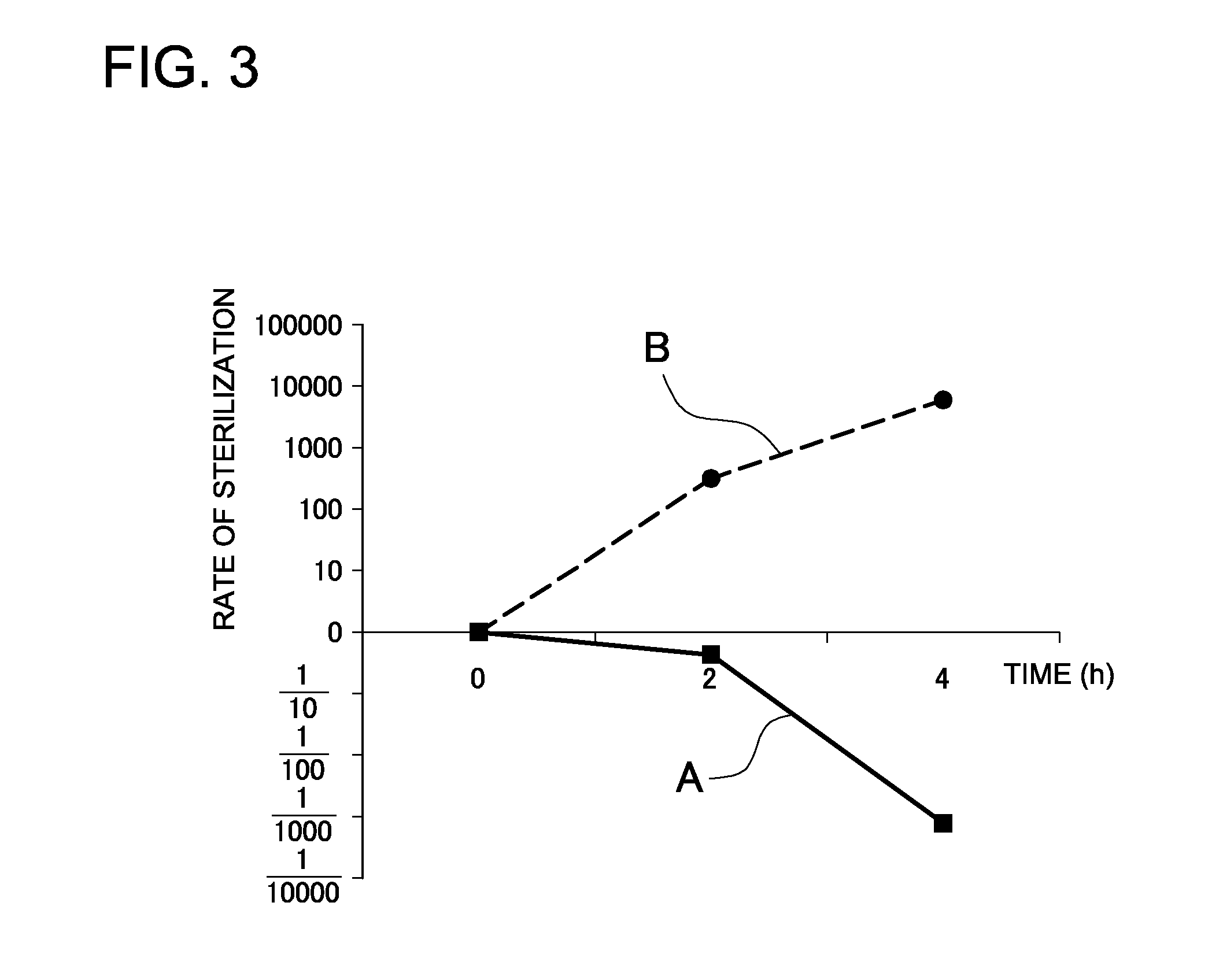Method for sterilizing fruits and vegetables
a technology fruits, applied in the field of methods for sterilizing fruits and vegetables, can solve the problems of reducing the sterilizing power, and high residual chlorine concentration on the surface of fruits and vegetables sterilized by the method, and achieve the effect of efficient sterilization
- Summary
- Abstract
- Description
- Claims
- Application Information
AI Technical Summary
Benefits of technology
Problems solved by technology
Method used
Image
Examples
example 1
[0053]The apparatus for sterilization in FIG. 4 is used for sterilizing cut vegetables of 400 g. As for this apparatus for sterilization, the agitator 1 of a cylindrical glass bottle having an outer diameter of 21 cm and a length of 20 cm is rotated for one hour at a rotation speed of 5 to 20 rpm. The agitator 1 is irradiated with UVA of 360 nm from an ultraviolet LED so as to have an intensity of ultraviolet light inside of approximately 10 mW / cm2. The agitator 1 is provided inside with the cut vegetables of 400 g and chlorine water of 2 l. The cut vegetables refer to shredded cabbage. The chlorine water is obtained by adding sodium hypochlorite to water to have a chlorine concentration of 6 ppm.
[0054]In the cut vegetables sterilized by the above apparatus for sterilization, sterilization is quite effectively performed to the extent that the number of bacteria becomes 1 / 3000. Further, the sterilization is performed without an odor of chlorine with a residual chlorine concentration ...
example 2
[0066]The following experiment verifies that the strongly acidic hypochlorous acid water having a low chlorine concentration provides an extremely excellent sterilization effect by being used with UVA. Strongly acidic hypochlorous acid water used for this test has a chlorine concentration of 0.25 ppm. The strongly acidic hypochlorous acid water having this chlorine concentration is produced by the following procedure. Water containing NaCl with a salinity of 0.002% by weight is supplied to the electrolytic cell. The water is electrolyzed to obtain strongly acidic hypochlorous acid water having a chlorine concentration of 12.5 ppm. The strongly acidic hypochlorous acid water is then diluted 50-fold.
[0067]A sterilization power of the strongly acidic hypochlorous acid water having the above chlorine concentration is measured by the following steps.
1. A mixed solution is prepared by mixing 100 μl (microliter) of a bacterial culture having OD6001.0 and 900 μl (microliter) of the strongly...
example 3
[0070]The following experiment verifies that the slightly acidic hypochlorous acid water having a low chlorine concentration provides an extremely excellent sterilization effect by being used with UVA. Slightly acidic hypochlorous acid water used for this test has a chlorine concentration of 0.1 ppm. The slightly acidic hypochlorous acid water having this chlorine concentration is obtained by the following procedure for use. Water containing NaCl with a salinity of 0.002% by weight is supplied to the electrolytic cell. The water is electrolyzed to produce strongly acidic hypochlorous acid water and slightly acidic hypochlorous acid water, followed by mixing these acidic hypochlorous acid water. Thus obtained mixed water is then diluted 50-fold.
[0071]A sterilization power of the slightly acidic hypochlorous acid water having the above chlorine concentration is measured by the following steps.
1. A mixed solution is prepared by mixing 100 μl (microliter) of a bacterial culture having O...
PUM
 Login to View More
Login to View More Abstract
Description
Claims
Application Information
 Login to View More
Login to View More - R&D
- Intellectual Property
- Life Sciences
- Materials
- Tech Scout
- Unparalleled Data Quality
- Higher Quality Content
- 60% Fewer Hallucinations
Browse by: Latest US Patents, China's latest patents, Technical Efficacy Thesaurus, Application Domain, Technology Topic, Popular Technical Reports.
© 2025 PatSnap. All rights reserved.Legal|Privacy policy|Modern Slavery Act Transparency Statement|Sitemap|About US| Contact US: help@patsnap.com



